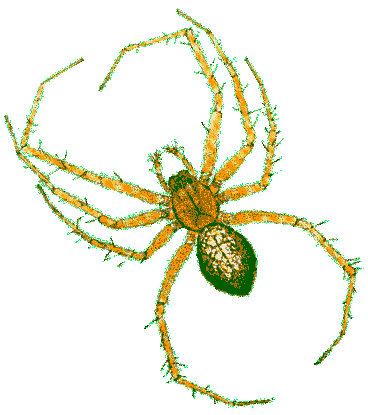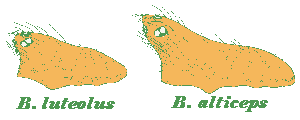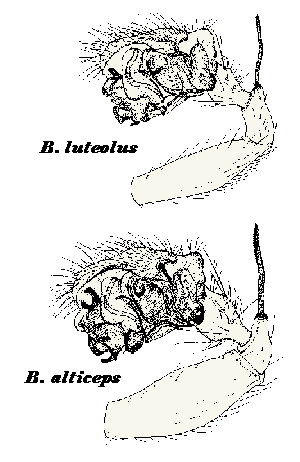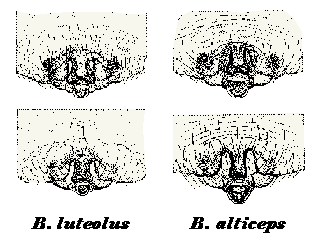

We're back in the great outdoors again for this month's species,
Bolyphantes
luteolus, which is a member of the family Linyphiidae.
The larger members of this family build quite conspicuous horizontal
sheet webs up in the vegetation on bushes etc., while small species hide
away under stones, in leaf litter, moss and similar micro-habitats.
With a size range of about 3-4mm, B. luteolus is of moderate
size and can be found in both of these situations. Its overall form, as
clearly shown in this illustration, is that of a web-spinner, with long,
flexible legs which are well equipped with sensory hairs, bristles and
spines The legs are rather spindly in comparison with the sturdy legs of
the fast-running ground hunters; you can see the contrast with the cursorial
wolf-spiders which have featured in earlier months (Pardosa
pullata in June, Trochosa terricola
in April).
There is another species of Bolyphantes in this part of the world:
B.
alticeps.
These two species are similar in size, similar in appearance and similar
in the various habitats that they occupy. Although B. luteolus is
widespread throughout Britain, B. alticeps is restricted to the
more northern regions of England and Wales as well as Scotland. So - in
our area we stand a chance of finding both species and need to differentiate
between them.
This problem is rather reminiscent of the two species that we looked at in October: Gonatium rubellum and G. rubens. Those two species were easily distinguished - the males by the shape of their carapace and tibia of leg I and both species by their genitalia.
Once again, we can look at the heads of the males to distinguish the
species,  with
B.
alticeps having a more pointed, elevated front bearing the eyes,
as shown here.
with
B.
alticeps having a more pointed, elevated front bearing the eyes,
as shown here.
We'll come back to strangely shaped heads next month as a New Year
treat with one of my favourite species
 The
males are also fairly easy to recognise on examination of their palps;
in particular there is a large spine on the patella (the 'knee' of the
palp) which on close examination differs greatly - in the words of Roberts:
"In B. luteolus the tip of the spine appears like the jagged edge
of a broken broomstick, whereas in B. alticeps the distal third
of the spine is tapered and serrated". This can be seen in the picture
here, but is much clearer in the figure in Roberts (1985), where the other
distinguishing features are also emphasised.
The
males are also fairly easy to recognise on examination of their palps;
in particular there is a large spine on the patella (the 'knee' of the
palp) which on close examination differs greatly - in the words of Roberts:
"In B. luteolus the tip of the spine appears like the jagged edge
of a broken broomstick, whereas in B. alticeps the distal third
of the spine is tapered and serrated". This can be seen in the picture
here, but is much clearer in the figure in Roberts (1985), where the other
distinguishing features are also emphasised.
 In
contrast, however, the females are not so easy to separate. Their overall
appearance is similar and the epigynes in both species show much variation
in structure, but are still similar as shown here. Indeed, careful measuring
may be needed to ascertain the species to which a female specimen belongs.
In
contrast, however, the females are not so easy to separate. Their overall
appearance is similar and the epigynes in both species show much variation
in structure, but are still similar as shown here. Indeed, careful measuring
may be needed to ascertain the species to which a female specimen belongs.
There are other species like this, with dimorphic males but indistinguishable females; for example in the genus Oedothorax there are a number of such species pairs such as Oe. gibbosus and tuberosus.
Perhaps these species-pairs may be sibling species, recently separated in evolutionary terms.
There may be habitat preferences separating these paired species. Over
a wide range of pitfall trapping sites, I have taken B. luteolus
in oak woodland and several peatbog locations, often wooded or with fairly
tall vegetation, whereas B. alticeps only appeared at one of these
sites - an upland, exposed peatbog with no trees and a mossy carpet beneath
short heather vegetation. This pattern of distribution was observed
in December - so these two species are our "spiders of the month".
The picture of B. luteolus is from Dr. Mike Roberts' book
: The Spiders of Great Britain and Ireland, published by Harley
Books in 1985, from which the other illustrations have been highly adapted. You'll need to look in the book to see the details clearly!
| Return to..? | |
 Ariadne Home Page
Ariadne Home Page |
|